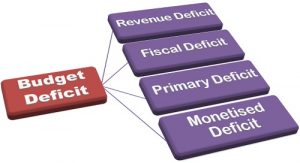Budgetary Deficit is the difference between all receipts and expenditure of the government, both revenue and capital. This difference is met by the net addition of the treasury bills issued by the RBI and drawing down of cash balances kept with the RBI. The budgetary deficit was called deficit financing by the government of India. This deficit adds to money supply in the economy and, therefore, it can be a major cause of inflationary rise in prices.
Budgetary Deficit of central government of India was Rs. 2,576 crores in 1980-81, it went up to Rs. 11,347 crores in 1990-91 to Rs. 13,184 crores in 1996-97.
The concept of budgetary deficit has lost its significance after the presentation of the 1997-98 Budget. In this budget, the practice of ad hoc treasury bills as source of finance for government was discontinued. Ad hoc treasury bills are issued by the government and held only by the RBI. They carry a low rate of interest and fund monetized deficit. These bills were replaced by ways and means advance. Budgetary deficit has not figured in union budgets since 1997-98. Since 1997-98, instead of budgetary deficit, Gross Fiscal Deficit (GFD) became the key indicator.
- The difference between total revenue and total expenditure of the government is termed as fiscal deficit. It is an indication of the total borrowings needed by the government and thus amounts to all the borrowings of the government . While calculating the total revenue, borrowings are not included.
- The gross fiscal deficit (GFD) is the excess of total expenditure including loans net of recovery over revenue receipts (including external grants) and non-debt capital receipts. The net fiscal deficit is the gross fiscal deficit less net lending of the Central government.
- Generally fiscal deficit takes place either due to revenue deficit or a major hike in capital expenditure. Capital expenditure is incurred to create long-term assets such as factories, buildings and other development.
- A deficit is usually financed through borrowing from either the central bank of the country or raising money from capital markets by issuing different instruments like treasury bills and bonds.
- Revenue deficit is concerned with the revenue expenditures and revenue receipts of the government. It refers to excess of revenue expenditure over revenue receipts during the given fiscal year.
- Revenue Deficit = Revenue Expenditure – Revenue Receipts
- Revenue deficit signifies that government’s own revenue is insufficient to meet the expenditures on normal functioning of government departments and provisions for various services.
- In India social expenditure like MNREGA is a revenue expenditure though a part of Plan expenditure.
- Its targeted to be 2.9% of GPD in the year 2014-15, though the fiscal revenue and budget management act specifies it to be zero by 2008-09
CGPCS Notes brings Prelims and Mains programs for CGPCS Prelims and CGPCS Mains Exam preparation. Various Programs initiated by CGPCS Notes are as follows:-
